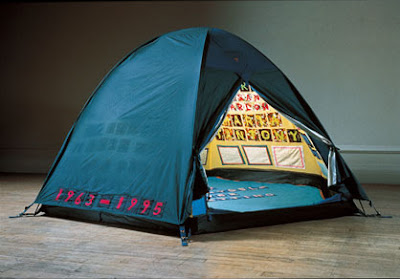Thoughts on Power and Brancusi's Endless Column
>> Tuesday, December 21, 2010 –
axi mundi,
Brancusi,
Endless Column,
symbol

How many epiphanies have descended in bathrooms? A late Constatin Brancusi piece and a childhood habit collided there recently. For years as a child, I would contemplate on my bedroom's manufactured ceiling tiles with the random punctuation; the kitchen floor with the vaguely repetitious pattern -- and wait to find faces; animals; grotesque caricatures with hats and strange proboscises. And while sitting in our home's bathroom, I still do the same thing: it's a short interlude of childhood, this looking for those same faces or patterns. The floor in our current bathroom does not foster much face-finding, but the hexagonal porcelain tile facilitates all manner of abstract geometric patterning and formation -- which corresponds to my current painting work, and keeps me thinking.
In the back of my mind, I've long questioned (gingerly and respectfully) Brancusi's Endless Column -- it seemed like such an offhanded gesture among so many of his strokes of brilliance. I questioned its power, its efficacy even: for goodness sake, the column is obviously not endless. And irony is fine, but it seems too shallow even for the beginning of irony. From what did this tower draw its undeniable gravitas -- even for a skeptic such as myself? I admit, until recently, I did not know.
Looking for patterns in the worn tile, stroking my innate attraction to Rorschach-type images and Jungian symbolism, suddenly one emerged -- one which I'd noticed before, but had never associated with Brancusi's Romanian column. Simultaneously, I realized the form's uncanny similarity to a taut, stretched accordion or concertina, bursting with the possibility of immense noise -- the infinitely tense pause of a captured breath in a fully-extended lung, forever silent on the cusp of a sound. Thus, like a rush, I finally understood the power -- the potential -- of Brancusi's piece: it benefits from the incredible power of the delayed moment; the possible blare; the state which causes the flinch in front of a wave of expected sound, thought to be imminent. To capture and express this emotional state was a brilliant (and perhaps unconscious) move. There is more coercive power in the possibility or anticipation of enormity, than there is in the final expression of it. Once captured energy is released (the squeezed accordion; the bawling child; the piercing whistle or sneeze; the aria's final note) there is a context which needs to be reacted against, and the actual capacity or power of the energy has been expressed. More energy must then be exerted to come to a similar state of powerful suspension. An unknown power is stronger than a known one, in theory; largely because of our imaginations. We (humans/observers) can imagine an almost infinite amount of power (related to our innate need for a divinity...but I digress). Withheld, that power is in essence infinite. Once expressed though, the actuality is known, and more likely than not, finite.
And thus, though Brancusi has finely expressed infinity (or perceived infinity) through the column, he has simultaneously expressed finiteness through the seemingly cheap irony of a column named Endless, with an undeniable material end. There's no getting around this, he says, in his prototypical peasant wisdom, fencing the line between profundity and simplicity...and mocking my epiphany. Not only is there no getting around the finiteness of this gesture, the form references common funerary markers of southern Romania (where the monument is to be found): a finite status if there ever was one -- as well as one laced with concepts of infinity (for those who ascribe to a future not fully defined by the present). Seen in this way, the formal constantly lapsing into the symbolic, the intertwining statuses of finiteness and infinity become even more integral. The form seems to reference in an even more basic way the axi mundi, the ancient and worldwide symbol found in multitudinous guises, of the universe's central pillar or bellybutton: a protean symbol of both origins and destinations, thus mixing past, present and future; the prime progenitive symbol of the world. The moniker of Endless becomes less ironic and more appropriate through this realization. Seen stylistically, as a form where angles interact in a consistent manner, between intersecting and diverting, it begins weaving a spiral and thus creates another primal form, uncovered in the 20th century and likely unknown to Brancusi: the double helix of DNA.
Months ago, I was inspired to write about the double helix as the universe's or nature's genetic center, after seeing two butterflies in a mating dance in flight, which drew that very shape in evanescent movement, up and up into the air, in a spiraling form. Are we seeing in Endless Column, Brancusi's contribution to this seemingly universal and shape-shifting, deeply seated and culturally diverse power symbol? I think so, and if so, it is indeed an "endless" column in that its pictorial, anecdotal and anthropological antecedents are legion, and eternal -- as far as I can see. Another proof that a work's title goes far beyond the work itself. Read more...

























